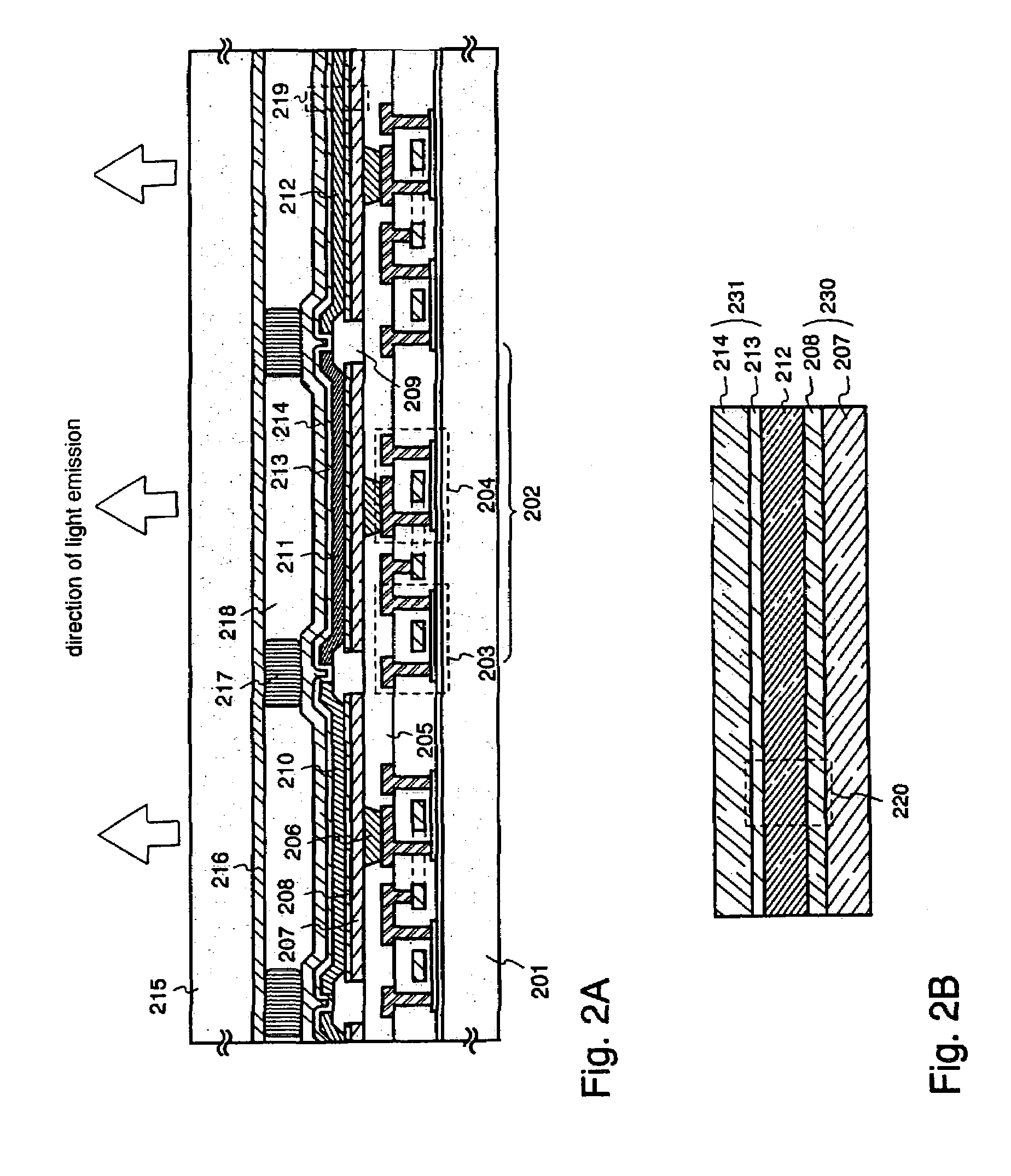Luminescent apparatus and method of manufacturing the same
a technology of luminescent apparatus and manufacturing method, which is applied in the direction of discharge tube luminescnet screen, discharge tube/lamp details, organic semiconductor device, etc., can solve the problems of early deterioration of organic el film, inability to apply a uniform voltage to the anode, and thermal treatment of over 150° c. , to achieve the effect of reducing resistance value and high quality
- Summary
- Abstract
- Description
- Claims
- Application Information
AI Technical Summary
Benefits of technology
Problems solved by technology
Method used
Image
Examples
embodiment ] 2
[Embodiment]2
[0097]In this embodiment, an EL luminescent apparatus having pixels the structure of which is different from that of the pixels of the EL luminescent apparatus shown in FIG. 2 will be described with reference to FIG. 7. The embodiment of FIG. 7 can be manufactured, by only slightly modifying the structure of FIG. 2, and will be described with attention paid to the points of the former embodiment which are different from the corresponding points of the latter embodiment. Therefore, concerning the parts of the embodiment of FIG. 7 which are designated by reference numerals identical with those used in FIG. 2, the statement under “Description of the Preferred Embodiment” may be referred to.
[0098]In the embodiment of FIG. 7, contact holes are formed in an interlayer insulating film 205, and a pixel electrode 701 and a first transparent electrode 702 are thereafter formed in the same condition, an insulating film 703 being then formed so as to fill recessed portions due to c...
embodiment ] 3
[Embodiment]3
[0104]Although only the construction of pixels is shown in the EL luminescent apparatuses shown in the mode of embodiment and Embodiment 1, a circuit for driving the pixels may be formed in a body on the same substrate. In this case, the driving circuit can be formed of an nMOS circuit, a pMOS circuit, or a CMOS circuit. It is, of course, allowable to form the pixel portions alone of TFTs, and use an externally fixed driving circuit, typically, an IC tip-including driving circuit (TCP and COG).
[0105]In Embodiment 1, the pixel portions are formed by p-channel type TFTs only, and the number of the manufacturing steps are thereby reduced. In this case, it is also possible to form the driving circuit by a pMOS circuit, and use an IC tip-including driving circuit as a driving circuit unable to be formed by a pMOS.
[0106]The structure of this embodiment can be put into practice by freely combining the same with the structure of Embodiment 1 or 2.
embodiment ] 4
[Embodiment]4
[0107]In this embodiment, an example using an amorphous silicon film as an active layer of switching TFTs and current control TFTs formed in pixel portions is shown. An inversely staggered TFT is known as a TFT using an amorphous silicon film, and can also be used in this embodiment.
[0108]Although a step of manufacturing a TFT using an amorphous film is simple, a size of an element becomes large. In the EL luminescent apparatus according to the present invention, the size of TFT does not have influence upon the effective emission surface area. Therefore, a more inexpensive EL luminescent apparatus can be manufactured by using an amorphous silicon film as an active layer.
[0109]The structure of this embodiment can be put into practice by freely combining with any of those of Embodiments 1-3. However, when the structure of Embodiment 4 is combined with that of Embodiment 3, it is difficult to manufacture a driving circuit of a high operating speed by a TFT using an amorpho...
PUM
 Login to View More
Login to View More Abstract
Description
Claims
Application Information
 Login to View More
Login to View More - R&D
- Intellectual Property
- Life Sciences
- Materials
- Tech Scout
- Unparalleled Data Quality
- Higher Quality Content
- 60% Fewer Hallucinations
Browse by: Latest US Patents, China's latest patents, Technical Efficacy Thesaurus, Application Domain, Technology Topic, Popular Technical Reports.
© 2025 PatSnap. All rights reserved.Legal|Privacy policy|Modern Slavery Act Transparency Statement|Sitemap|About US| Contact US: help@patsnap.com



